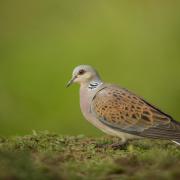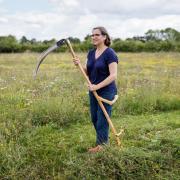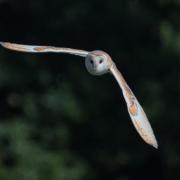Matt Gaw wonders at the stories behind some of the carvings on ancient trees at Knettishall Heath

It starts raining as I’m heading back along the river, heavy drops exploding into the Little Ouse. The surface of the water boils and jumps, and the land jumps with it – puffs of dust firing into the air like tiny volcanoes. The smell is pure unmistakable summer, cool rain on warm earth.
I walk across the car park, past the entrance to Knettishall Heath and lean over the bridge, enjoying the sensation on the back of my neck, the drumming on my head. I can feel the water seeping through my shirt, chilling my shoulders and running down my spine. I’m soaked to the skin but I decide to take shelter under an old beach, its boughs looped down like its ready to link arms with its neighbours.
I always think it’s strange how some trees can seem regal and austere while others are so eminently sociable. This tree is more sociable than most. Pen-knifed into its smooth, grey bark are the names of the people who have played here over the decades. Children, teenagers and adults. I trace a heart with a finger, its outline swollen and distorted with age, ‘Shirley’ carved into its centre. The heart is pumped up with decades of growth, the outlines shifting and beating around the name. Looking more closely I can see another cut, a more recent addition, an attempt to strike out the name. I wonder if it’s an act of sabotage or a sign that love doesn’t last as long as trees. I hope the former.
Many of the carvings are dated too. While some are patently false, belied by the freshness of the cut or alluding to a time when the tree would have been little more than a three-angled nut, others have a ring of authenticity. They have stretched with time, the letters ballooning with the stretching bark like widening footprints in melting snow. Once they formed a quiet romantic statement – a shared memory of a special time and place – but now they are wrapped around half a trunk in a cap-locked shout.
I dash to the next two trees, both of which have their own stories. I say the names and initials out loud, to no one in particular, raising my voice above the first clatter of thunder. It reminds me of a friend who, on moving house, insists on finding out the names of the previous owners and shouting them from the top of the stairs. He says he enjoys the thought that they haven’t been spoken in the house for decades but it also reminds him he is a just a custodian; ephemeral flesh bouncing off of enduring walls. Standing here in Knettishall I feel the same. All these people have experienced these trees and enjoyed this space before me. That they are still being enjoyed is something to be celebrated. May be I am wrong, but I can’t help thinking that these markings aren’t graffiti, but a logbook of love – a place where people have, often quite literally, carved their hearts into the landscape.
I know of another beech not far from here that is also tattooed with old names. Once a part of Bradfield Woods near Bury St Edmunds – the home to ancient coppices that attest to the intimate history between trees and humans – it now stands alone. The preservation order that halted the bulldozers in the 1970s and paved the way for what is now a treasured National Nature Reserve managed by Suffolk Wildlife Trust came too late for much of the woodland that once swaddled it. As a result, the memories on its trunk make for harder reading.
Suffolk Wildlife Trust is running a campaign to create a memory bank of people’s childhood experiences of nature. To find out more www.suffolkwildlifetrust.org



























